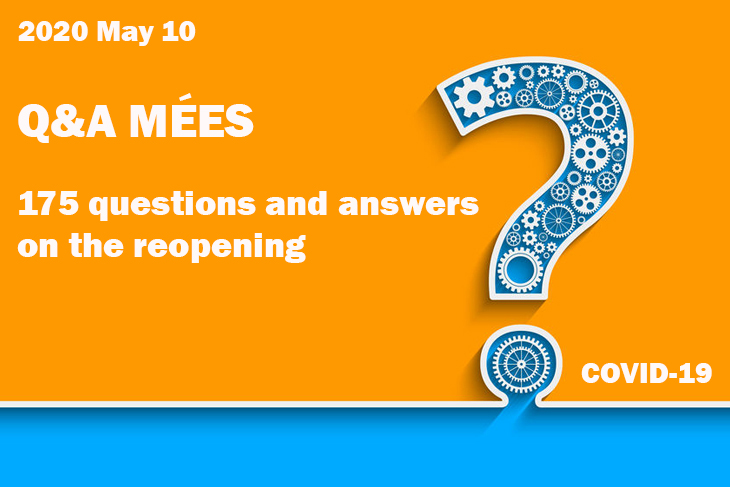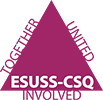21 May 2020

The document produced by the MÉES has been updated. It contains 175 questions and answers. Here are some of the elements more relevant to school support staff.
Procedures for confirmed cases of COVID-19 (Q2 modified)
The criteria for an infected person (staff or student) returning to school have been clarified:
-A period of at least 14 days since the onset of the disease in its acute phase;
-an absence of acute symptoms for 24 hours (excluding a residual cough which may persist);
-an absence of fever for 48 hours (without taking antipyretics).
Ratio 1:15 in daycare services (Q21 modified)
The text was identical to the one published on May 6, but was not marked “modified”, resulting in a vague interpretation. We intervened in an attempt to maintain the 1:10 ratio that existed in the emergency daycares. Unfortunately, the ratio will be 1:15 in school daycares.
Social workers from the Health and Social Services sector available to meet with students in the schools (new Q38)
They will be available to meet students when necessary, to ensure their well-being, security, and optimal development.
Handling of documents, teaching materials and games (Q49 modified)
The previous Q&A document referred to the CNESST guide. This still applies and it specifies that the sharing of tools and equipment must be restricted. When a common item is used, it should be cleaned after a student uses it.
Exceptional cases that exceed the maximum of 15 students per group (new Q69)
The text refers to a teacher who could have 16 or 17 students, but there is no mention of support staff. But school daycares will also be affected with the alternation between teaching/daycare. It is permissible to exceed 15 students per group in a gymnasium or an exceptionally large room. This exceeding of the limit must be exceptional and cannot involve more than two extra students. Distancing must be maintained, it must be a solution of last resort to avoid moving a sub-group to another establishment, and the school board must approve this exceeding of the limit.
Distribution of printers and cameras based on availability in each school board (new Q87)
School boards will ensure distribution based on availability, while promoting online tools. Educational resources can be sent in the mail.
School transport: siblings on the same bench, but distanced from others (Q104 and Q106 modified)
Siblings were already being allowed to sit on the same bench, but 2-meter distancing must be respected with the students on other benches. Since one student will be sitting next to the aisle, this restricts the possibility of there being other students in the adjacent bench.
Other tasks for staff with vulnerabilities (Q123 modified)
The list of exemption regulations for those with chronic diseases has not changed. It still includes:
-One or more of the following chronic diseases:
• chronic “uncontrolled” or “complicated” cardiac or pulmonary disorders which are serious enough to require medical monitoring or hospital care;
• “uncontrolled” or “complicated” diabetes which is severe enough to require regular medical monitoring or hospital care;
• liver problems (including cirrhosis) and “complicated” chronic kidney disease, severe enough to require regular medical monitoring or hospital care;
- “uncontrolled” or “complicated” hypertension, severe enough to require regular medical monitoring or hospital care;
– Significant obesity (BMI ≥ 40, for example).
– A medical condition causing a decrease in the evacuation of respiratory secretions or risks of aspiration (e.g.: a cognitive disorder, a spinal cord injury, a convulsive disorder, neuromuscular disorders).
New elements
Here are the new elements in this answer: “These people may be assigned to different tasks other than those usually assigned to them. For health and safety reasons, these people are encouraged to delay their return to school until September 2020.”
It is also specified that each situation must be assessed on a case-by-case basis, asking the school boards to “be flexible and to consider all the accommodations necessary for employees who could present increased risks.”
If you have any questions or require clarification, don’t hesitate to contact your local union which is used to dealing with your school board. The regulations are complicated and the case-by-case approach demands caution.
Fears for the health of loved ones (Q124 modified)
There are still no exemption regulations applicable to the health of loved ones, but school administrators and HR managers “are invited to take into account” such requests when assigning tasks.
Workplace meetings to be avoided (Q125 modified)
Administrators should favor telephone meetings or videoconferences. If face-to-face meetings are required, distancing must be maintained.
Working in several places (Q133 modified)
There is no longer a recommendation to limit travel between two establishments. There may be several.
Support measures for people experiencing significant stress when returning to work in the schools (new Q148)
People should refer to their employee assistance programs (EAP). The CNESST has prepared a reference guide on psychosocial risks in the workplace. The government announced a mental health action plan on May 6 that will specifically deploy more resources to improve and increase the provision of psychosocial and mental health services.
Risk of contamination during an intervention with a child where it is impossible to respect the distancing regulations (a student who falls or is injured) (new Q149)
We refer to the INSPQ document, Mesures pour la gestion des cas et des contacts dans la communauté.
According to the INSPQ, in order to facilitate risk assessment and the management of people who have been exposed to a case, exposure can be categorized according to four risk levels: high, moderate, low and not significant.
Risk is categorized as low if the person had short-term contact (less than 10-15 minutes), within two meters, with a confirmed or probable case. It is important to note that unless there is an outbreak in a community, the probability of a child being a confirmed or probable case is not significant. So, in a situation where social distancing cannot be maintained when a child falls or is injured, the risk of contamination is very minimal. It is recommended that the teacher apply hygienic measures (e.g., washing hands, not putting their hands on the face, etc.).
Difficulties finding a daycare space (new Q150)
The Ministry of the Family refers us to the Emergency daycares.
School boards are responsible for personnel management. It is therefore up to the school board to assess each particular situation based on its own circumstances. Principals and human resource managers are, however, encouraged, when possible, to reassign staff who cannot report to work for exceptional reasons to other duties that may be performed by telework.
